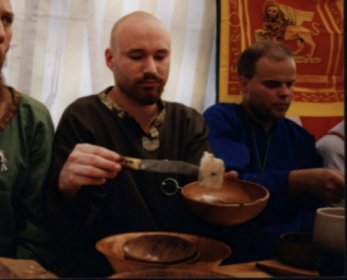We have heard how
south in Iceland
Gunnar guarded well
himself,
Boldly battle's
thunder wielding,
Fiercest foeman
on the wave;
Hero of the golden
collar,
Sixteen with the
sword he wounded;
In the shock that
Odin loves,
Two before him tasted
death.
(From Njal's
Saga)
Many people
believe that the Vikings where barbarians who plundered and burned their way
across the known world,not caring for their own lives or the lives of others,interested
only in destruction and pillage. It is true that the Vikings did pillage and
plunder but this is only part of the story. The energy that made them famous
for these raids was also used in positive ways
like exploration and trading.
Islendinga
members research and recreate the costume, tools, domestic implements, food,
armour and weapons of the Viking age. Our club is also centered in spirit
and in focus around Iceland, a country settled by the Vikings in the late
9th century. This information and equipment allows Islendiga to arrange presentations
on the domestic, cultural and martial aspects of the Viking age. The audience
is encouraged to see, hear, taste and touch the past and obtain a better understanding
of the Vikings through interacting with the display.


The
Vikings loved feasts, and Islendinga attempts to recreate the food and abmbience
of a medieval feast as closely as possible. For food, this means that "New
World" items such as tomato or potato are not used. Authentic recipes are
followed, and for a typical feast this would include fare such as smoked fish,
strained whey, roast chicken and pig. Vikings were known to prefer mead (a fermented
honey drink) but also consumed cider and ale at their feasts. Rich Vikings also
drank imported wine from Germany. Setting for the feast is also important. We
ensure no bottles are in view on tables and that all guests are wearing Viking-era
clothing.


Viking clothing
tended towards the plain and useful. Men wore a simple tunic of wool over
linen pants which had no pockets. Their belongings were carried in leather
pouches or bags they hung from their belts. Women wore a long, ankle-length
dress covered with an apron. Both sexes were fond of decoration, however,
and Islendinga prides itself on the accurate recreation of jewellery. Women
carried distinctive bronze brooches at the shoulder along with thick necklaces
of amber and silver. Many men wore their Thor's hammer, Thor being the God
favoured by the common folk. Other common subjects for jewellery were dragons
and weapons such as axes or swords.


Islendinga
recreates Viking combat using weapons that closely resemble the originals, but
are blunted for reasons of safety. As such, we take extreme care both when training
with each other and fighting with other clubs. Our main weapons are the sword,
the short axe, spear and two-handed axe. Each member of the club usually learns
one of these as his or her primary weapon and in time takes up each of the others.
Variety has always been important to Islendinga on the field, as a good mix
of axes, spears and swords usually sways the odds in your favour. Rather than
fight as a military unit, we prefer to use our stronger fighters to back up
the newer members of the club. Watching each other's backs is never easy but
ensures that your force can hold its own against superior numbers.
Last revision
01/05/2000 by Nick
Smith of the Islendinga Viking Society










